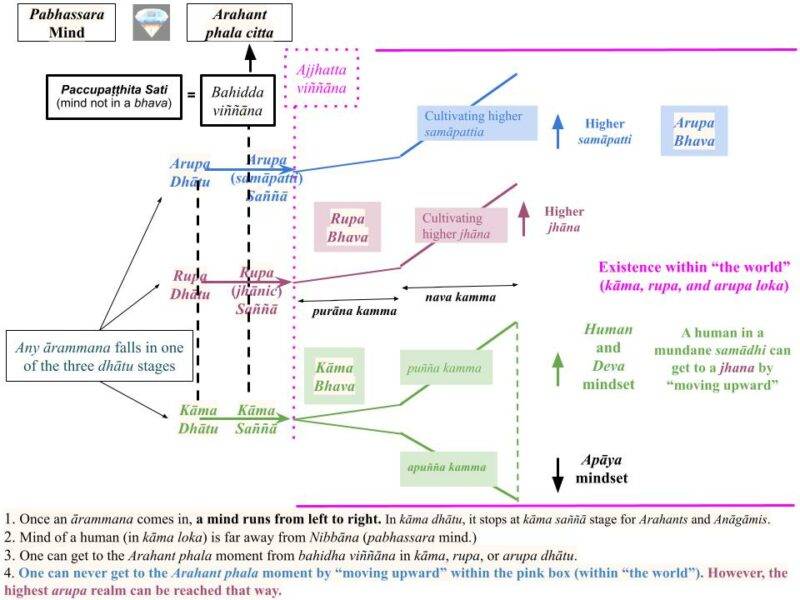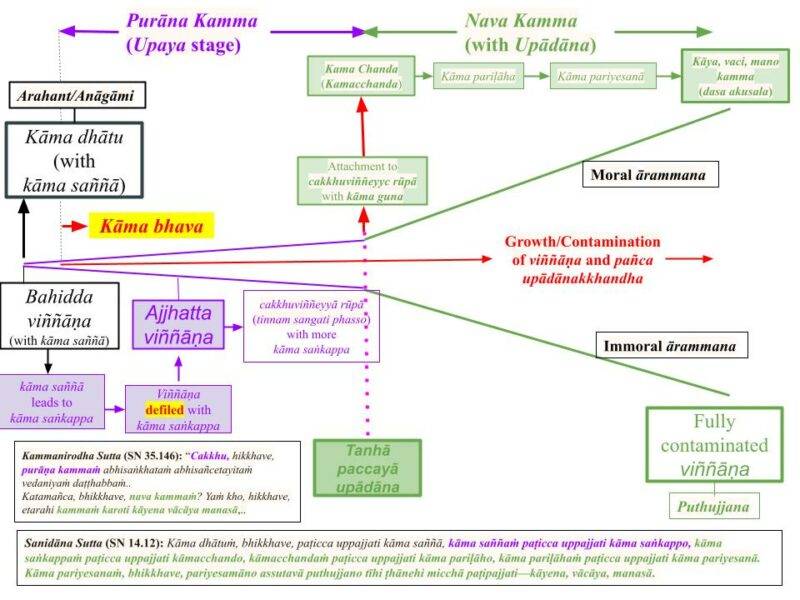The “Mahāsatipaṭṭhāna Sutta (DN 22)” is not even in the niddesa version; it is in the uddesa version and requires many fundamental concepts to understand. I have realized that the description I have given in “Maha Satipaṭṭhāna Sutta” is a superficial one. However, it is a good start. We need to discuss some more background material, and the following chart points out some key points.

Download: “Purana and Nava Kamma -4“
1. A sensory event (arammana) in this world causes a mind to first land on one of three “dhatu” or “initial stages” in one of the three lokas: kama loka, rupa loka, or arupa loka.
- Since humans are in kama loka, our minds start at the “kama dhatu” stage. A rupa loka Brahma‘s mind will fall on the “rupa dhatu” stage, etc. The following steps happen in rapid succession without us being aware. I will only focus on the human mind.
- Immediately, it gets to the “kama sanna” stage with the “distorted sanna.” This is the “bahidda vinnana” stage, and if it can be stopped there (as is the case for Arahants), it is the “paccupaṭṭhita sati” per Dosakkhayo’s question.
2. The following steps ALWAYS occur for a puthujjana (an average human.)
- The mind enters “kama bhava” with “ajjhatta vinnana” and proceeds to get “increasingly defiled.” I provided the following chart on July 30, 2024 at 10:07 am:

Download/Print: “Purāna and Nava Kamma – 2- revised“
- It is from the post: “Purāna and Nava Kamma – Sequence of Kamma Generation” which I highly recommend. Of course, one needs to keep going back to earlier posts to “fill in gaps.”
3. I provided following information in my comment on July 31, 2024 at 3:58 pm:
___________
“1. When a sensory input (arammana) comes in, the mind first experiences “bahiddha vinnana.” The term “bahiddha” means “bahira + iddha” where “bahira” means external and “iddha” means ” to get established.”
- A human mind (or vinnana) is first established in the “dhatu” or “initial stage,” where a “set of distorted kama sanna” is automatically experienced regardless of whether or not one has any magga phala.
- That is what gives the “sweetness of sugar,” “beauty/handsomness” of a woman/man, etc.
2. That “kama sanna” then triggers “kama sankappa” (mainly mano abhisankhara) based on one’s samyojana/anusaya.
- For example, since all ten samyojana are intact in a puthujjana, they generate the strongest “kama sankappa.“
- A Sotapanna has removed three samyojana, and hence the attachment will be less, etc..
- Since this “attachment” is based on one’s ditthi, tanha, and mana, it is called “ajjhatta” (“ajjha” for “oneself” and “atta” for “taking it to be fruitful.”
- Since an Arahant has no samyojana (or ditthi, tanha, and mana) left, that mind will not get to this stage, i.e., no pancupadanakkhandha (PUK) gets started.
3. The “ajjhatta vinnana” is the beginning of the accumulation of a PUK.
- In the next step, the mind makes its own version of the “external rupa” received. This is the “cakkhuvinneyya rupa” for visual input (as indicated in the figure.)
- In most suttas, by “rupa” it is meant the “cakkhuvinneyya rupa.” P.S. This is the rupa that is of “anicca nature,” not the “external rupa.” This “rupa” (it is related to the “namarupa” in PS) arises in the mind only because that mind has not fully grasped the “anicca nature” (of course, that happens at the Arahant stage).
4. In the next step, “kama guna” arises based on one’s gati at that moment.
- Thus, the same person may be attracted to a sensory event while drunk, for example, but may not while in a “good mindset.”
5. The mind gets to the “tanha paccaya upadana” stage only if the attachment is strong in the above step.
- This is really the time the PUK (pancupadanakkhandha) starts. This is the “upadana” stage where “new or nava kamma” are accumulated, as indicated at the top of the figure.
- Thus, the stage before that is called the “upaya stage.” No significant kamma is accumulated in this stage, as indicated by the narrow expansion of the “cone.”
- Strong kamma are accumulated in the “nava kamma stage” with kaya, vaci, and mano abhisankhara. That is indicated by the “widening cone” starting at the “tanha paccaya upadana” stage.
- Also, the “expansion” indicates “punna kamma” and the downward indicates “apunna kamma” or immoral kamma.
6. The “purana kamma” (or “upaya“) stage arises automatically according to one’s samyojana/anusaya. We don’t have direct control over that stage.
- However, in the “nava kamma” (or “upadana“) stage, kamma is accumulated consciously.
- The mind gets increasingly contained as it goes through the steps shown.
- In the “cleansing process” (or cultivating “sila” or “indriya samvara“), one needs to start at the rightmost stage.
7. I have provided more information in the comment above the one with the figure.
- As discussed there, the removal of samyojana/anusaya, (as well as one’s gati) happens by cultivating mindfulness/sila/indriya samvara AND understanding the details of this kamma accusation process, i.e., how a PUK arises with an arammana.
- Reading the links given will help you understand the process.
- Also see “Ārammaṇa (Sensory Input) Initiates Critical Processes.” (especially #11). However, one will eventually need to read posts in the time sequence given in “New / Revised Posts” from around 7/29/23.”
_______
4. A few more points to clarify the first chart on the top:
- The processes in the right-hand portion of the chart (bounded by the pink lines) occur in the world of 31 realms, i.e., kama loka, rupa loka, and arupa loka.
- For example, an anariya yogi can keep the mind on the “upward trajectory” and get to the lowest realm in the “rupa loka,” i.e., first jhana. That requires much effort since one cannot allow the mind to “fall back.” That is why they had to go deep into jungles and away from the distractions! Once there, they can proceed up the ladder to reach even the highest arupa samapatti.
- Then, they will be reborn in the Brahma realm, corresponding to the highest jhana/samapatti they attained.
- However, since they had not eliminated nay samsaric bonds (samyojana), they always are reborn in the human realm after their lifetime in such a Brahma realm.
5. Now, here is the critical information necessary to cultivate Satiptthana Bhavana:
- A puthujjana must first comprehend the fundamentals of Buddha Dhamma (Noble Truths/Paticca Samuppada/Tilakkhana) and attain the Sotapanna stage.
- Sotapanna can start cultivating Satiptthana by first comprehending the charts above.
- As the charts indicate, the human mind automatically runs from the left to the right, getting increasingly defiled. Now, one must first engage in “indriya samvara” or “indriya bhavana” (moral discipline of a Sotapanna or “ariyakanta sila“) and start going backward (from right to left)!
- One must abstain from apunna kamma and not go downward.
- Once overcoming the “expanded cone” (which represents the drastic expansion after the “tanha paccaya upadana” step in PS), one must engage in formal meditation (Vipassana/insight mediation), i.e., contemplation of anicca, dukkha, anatta nature.
- That is the process to reach the “bahidda vinnana” or the “paccupaṭṭhita sati” stage at the beginning of kama dhatu.
- From here, one can engage in Vipassana/insight mediation and reach a higher magga phala.
- Some people automatically get to the first jhana once reaching the “paccupaṭṭhita sati” stage. They will experience the “distorted sanna” (jhanic sukha) of the first jhana. Many people attach to that and get to the “nava kamma” stage in rupa loka and get stuck there.
- However, if one attains the Anagami stage from the “paccupaṭṭhita sati” stage in kama loka, then they will land on the “paccupaṭṭhita sati” stage of the rupa loka. They must cultivate Vipassana/insight mediation and could get to the Arahant stage. Otherwise, they can go through the arupa samapatti stages using the same basic process.
6. A Sotapanna may reach the Arahant stage without going through any jhana/samapatti.
- Or they could attain a jhana and get to the Arahant stage from the rupa loka level.
- A few go through all rupa loka jhana and arupa loka samapatti and become ubhatovimutta Arahants.
I hope the above will help get a general idea.
